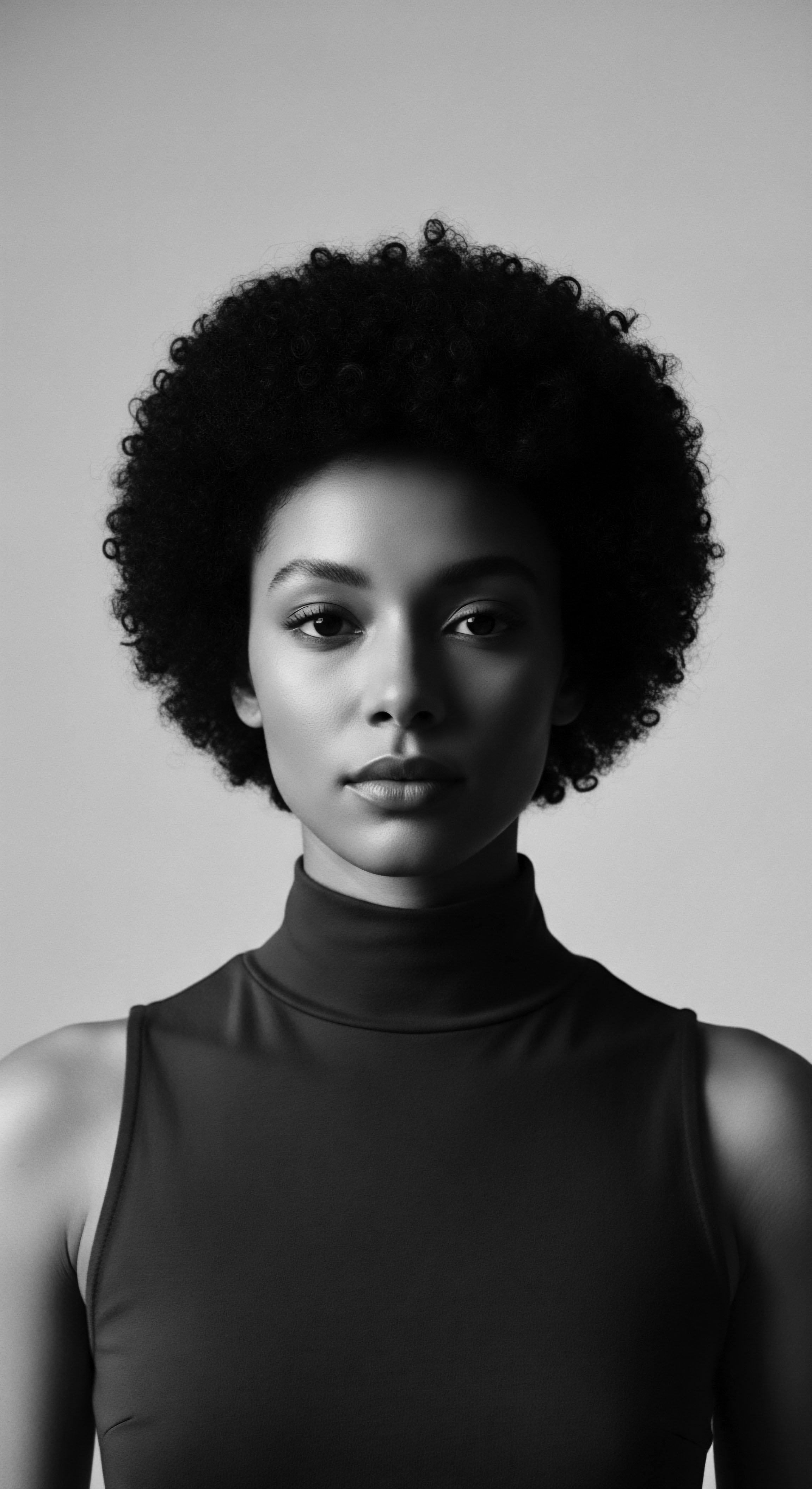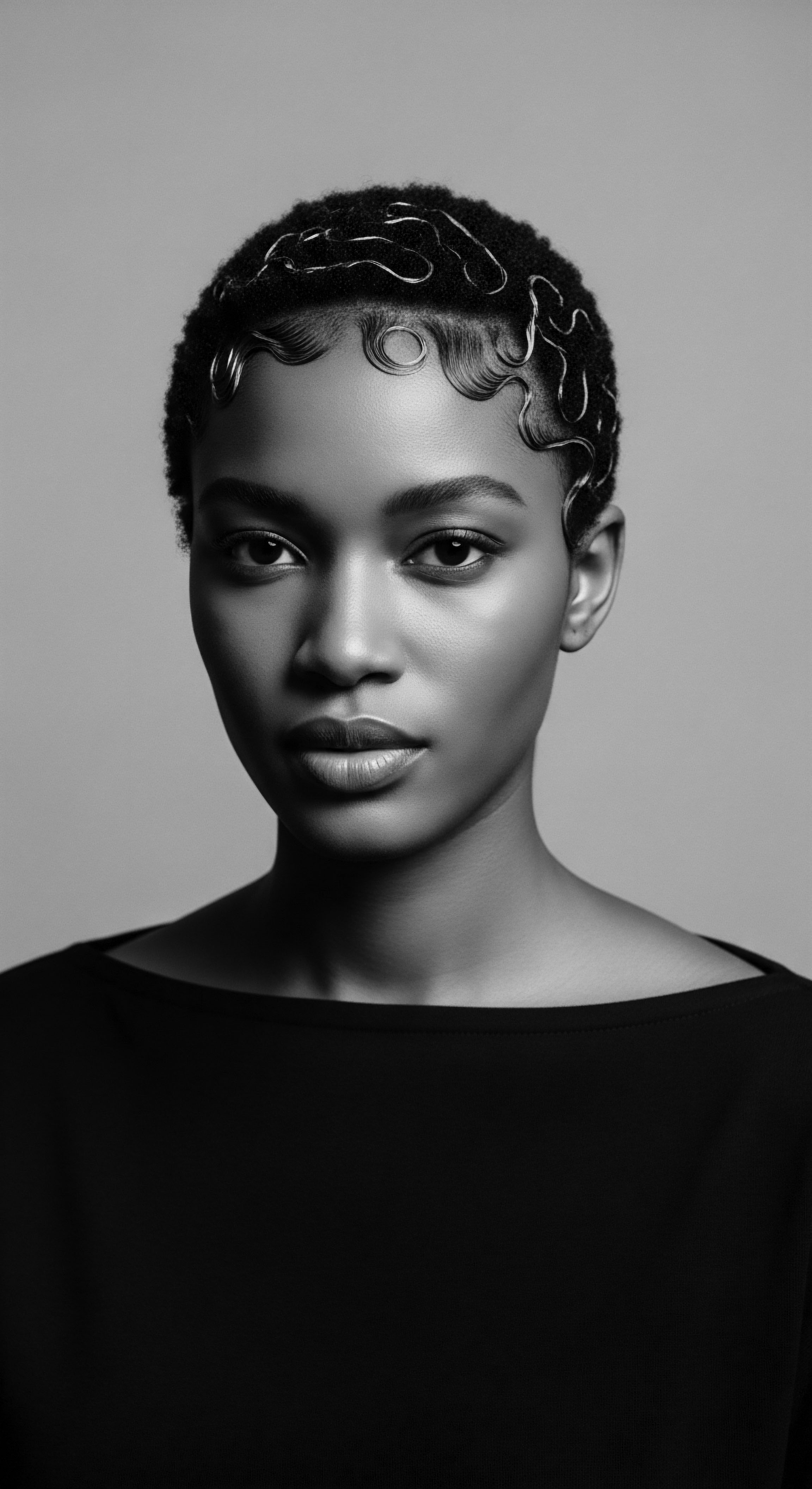
Fundamentals
The phrase “Slavery Hair Practices” encompasses a profound and complex historical phenomenon, representing both the dehumanizing impositions upon the hair of enslaved African peoples and the ingenious, resilient adaptations forged in response. It is a critical lens through which to comprehend the enduring spirit of textured hair heritage, revealing layers of oppression, survival, and profound cultural preservation. This initial delineation aims to provide a foundational understanding for those newly encountering this somber yet deeply meaningful chapter in hair’s long story.
At its elemental level, the concept of Slavery Hair Practices refers to the spectrum of ways hair was managed, manipulated, and perceived during the transatlantic slave trade and the subsequent eras of chattel slavery. This period saw a deliberate and systematic dismantling of African cultural norms, including those surrounding hair, alongside the coercive implementation of practices designed to control, demean, and assimilate. Understanding this dual reality is paramount; it was not merely about hair styling, but about the very essence of identity, dignity, and ancestral connection.
For many, the mention of this historical period conjures images of suffering, yet within that suffering existed an undeniable tenacity. Hair, a visible marker of identity and lineage in many pre-colonial African societies, became a site of both immense vulnerability and quiet resistance. The enforced conditions often stripped individuals of their ability to care for their hair in traditional ways, leading to significant challenges in hygiene and maintenance. However, even within these constraints, ancestral knowledge persisted, whispering through generations and guiding improvised methods of care.
Slavery Hair Practices represent a stark historical duality ❉ the forced suppression of ancestral hair traditions juxtaposed with the indomitable spirit of cultural survival and creative adaptation.
The rudimentary meaning of “Slavery Hair Practices” begins with the basic understanding of how hair was managed under duress. Enslaved individuals often lacked access to proper tools, cleansing agents, or the communal time necessary for traditional hair rituals. This environmental scarcity, coupled with the brutal realities of forced labor, meant that hair care was often reduced to its most functional aspects ❉ keeping it out of the way, preventing infestation, and enduring the daily grind.
Yet, even in this harsh environment, the deep-seated cultural significance of hair could not be entirely extinguished. The communal act of tending to one another’s hair, even in secret, became a vital, unspoken language of solidarity and remembrance.
The designation of “Slavery Hair Practices” also brings into sharp focus the forced erasure of pre-existing African hair traditions. Before the transatlantic abduction, hair was an elaborate canvas, conveying social status, marital status, age, spiritual beliefs, and tribal affiliation. Each braid, each adornment, each intricate pattern carried a specific sense, a shared understanding within a community.
The violent rupture of slavery sought to sever these connections, imposing a new, often humiliating, set of standards or a complete disregard for hair’s symbolic weight. This forced detachment from ancestral practices created a void, yet paradoxically, it also sparked a quiet, persistent yearning to reclaim and redefine hair’s meaning in the crucible of a new, brutal existence.

Intermediate
Moving beyond the fundamental grasp, an intermediate comprehension of “Slavery Hair Practices” requires a deeper consideration of the profound psychological and sociological dimensions woven into this historical phenomenon. It compels us to acknowledge the strategic nature of hair’s manipulation within the apparatus of enslavement and, concurrently, the ingenious methods of resilience employed by those whose bodies and spirits were bound. This exploration begins to bridge the chasm between basic historical facts and the enduring legacy of textured hair heritage.
The intention behind many imposed hair practices was not merely practical; it carried a potent connotation of dehumanization. Forcing enslaved individuals to shave their heads, or denying them the means to maintain their hair, served as a powerful tool of subjugation. It aimed to strip away identity, to sever visible ties to ancestral lands and traditions, and to enforce a stark, uniform subservience.
The very act of neglecting or defiling hair, once a source of pride and cultural identification, became a daily reminder of one’s diminished status within the oppressive system. This deliberate degradation contributed to the immense psychological burden carried by enslaved people, making every strand a silent witness to profound suffering.
Yet, within this crucible of oppression, an extraordinary counter-narrative of ingenuity and defiance took root. Enslaved people, drawing upon inherited wisdom and an innate drive for self-preservation, transformed hair care into an act of covert resistance and communal bonding. The very restrictions placed upon them spurred creative solutions.
Hair was often braided tightly to minimize maintenance, protect delicate strands from harsh labor, and, in some remarkable instances, to conceal precious items or convey vital information. This quiet ingenuity speaks volumes about the indomitable human spirit.
Beyond mere physical management, Slavery Hair Practices reveal a battleground for identity, where forced degradation met clandestine cultural preservation and defiant self-expression.
Consider the profound significance, for example, of cornrows. This ancient African braiding technique, often viewed today as a style choice, held a deeply subversive purport during slavery. Accounts suggest that intricate cornrow patterns were sometimes used as literal maps to freedom, their twists and turns charting escape routes or indicating safe houses along the Underground Railroad. Furthermore, enslaved women, with incredible foresight, would occasionally braid seeds—rice, okra, or other staples—into their hair before or during the perilous Middle Passage, ensuring the possibility of sustenance and agricultural continuity upon arrival in an unknown land (Byrd & Tharps, 2001, p.
19). This specific historical example powerfully illuminates the direct connection between hair practices and survival, demonstrating hair as a vessel for ancestral knowledge and a silent tool of resistance. It showcases how a seemingly simple act of hair styling carried the weight of generations and the promise of future survival, deeply embedding itself within the textured hair heritage.
The communal aspects of hair care during slavery also hold significant meaning. Despite the scarcity of resources, shared moments of hair grooming became sanctuaries of solace and connection. These gatherings, often conducted in secret, allowed for the exchange of news, the sharing of stories, and the quiet reaffirmation of cultural bonds.
It was during these tender moments that ancestral practices, however modified, were passed down, ensuring a continuous thread of tradition. The act of tending to another’s hair became an expression of care, trust, and mutual support, strengthening the collective spirit against overwhelming adversity.
| Imposed Practices (Dehumanization) Forced head shaving or cutting hair short to strip identity. |
| Adapted Practices (Resilience & Heritage) Developing protective styles (e.g. tight braids, head wraps) for minimal maintenance and concealment. |
| Imposed Practices (Dehumanization) Denial of traditional tools and cleansing agents. |
| Adapted Practices (Resilience & Heritage) Ingenious use of natural materials (e.g. clay, plant oils, kitchen grease) for conditioning and cleansing. |
| Imposed Practices (Dehumanization) Imposition of European beauty standards, leading to self-perception issues. |
| Adapted Practices (Resilience & Heritage) Maintaining traditional braiding patterns as cultural markers and forms of covert communication. |
| Imposed Practices (Dehumanization) Hair as a symbol of dirtiness or wildness, reinforcing negative stereotypes. |
| Adapted Practices (Resilience & Heritage) Communal hair grooming as a sacred space for bonding, storytelling, and cultural continuity. |
| Imposed Practices (Dehumanization) The hair practices during slavery underscore both the profound cruelty of the system and the enduring, inventive spirit of those who resisted its totalizing grip. |
The impact of these practices on textured hair heritage cannot be overstated. The forced adaptations, born of necessity and resistance, laid the groundwork for many hair care techniques that persisted through generations and still resonate today. The emphasis on protective styles, the ingenuity in utilizing available resources, and the deep communal value placed on hair care all stem from this period. It is a legacy of both hardship and incredible strength, a testament to how even under the most brutal conditions, the spirit of heritage finds a way to endure and manifest itself.

Academic
From an academic perspective, the term “Slavery Hair Practices” transcends a mere historical description; it functions as a critical framework for analyzing the intricate interplay of power, identity, resistance, and cultural transmission within the context of chattel slavery. This expert-level interpretation demands a nuanced understanding of its socio-historical underpinnings, its psychological ramifications, and its enduring influence on contemporary textured hair experiences. It is a concept that necessitates rigorous scholarly examination, drawing upon anthropology, sociology, cultural studies, and the history of medicine.
The explication of “Slavery Hair Practices” at this level acknowledges its dual nature ❉ the imposed and the adaptive. On one hand, the institution of slavery systematically deployed hair as a mechanism of control and degradation. The violent severance of familial and communal ties upon arrival in the Americas often commenced with the shaving of heads, a symbolic act designed to strip individuals of their pre-existing identities and communal markers. This act, alongside the deliberate denial of traditional grooming tools and products, fostered conditions of forced neglect, contributing to physical discomfort and profound psychological distress.
Such practices were not incidental; they were calculated components of a larger strategy to atomize enslaved populations, to dismantle their self-perception, and to render them anonymous, interchangeable units of labor. This historical reality provides a sobering denotation of the term.
Conversely, and perhaps more profoundly, “Slavery Hair Practices” signifies the extraordinary ingenuity and cultural tenacity of enslaved Africans. Despite the relentless pressures, they transformed hair care into a clandestine space for cultural continuity and subtle defiance. This involved the adaptation of ancestral techniques to new, often hostile, environments. For instance, the use of kitchen fats, animal greases, and locally available herbs for cleansing and conditioning hair represents a powerful example of ethnobotanical improvisation under duress.
These were not merely acts of hygiene; they were acts of memory, connecting the present to a distant, revered past. The very act of maintaining one’s hair, however crudely, became a quiet assertion of selfhood against a system designed to deny it.
Slavery Hair Practices reveal how hair, under duress, transformed into a potent medium for coded communication, ancestral remembrance, and unwavering self-affirmation.
A deeper understanding of this phenomenon requires examining the semiotics of hair within pre-colonial African societies, juxtaposed with the violent re-signification of Black hair under slavery. Before forced migration, hair was a vibrant lexicon, communicating social status, spiritual beliefs, and lineage with remarkable precision. Hair styles were often indicators of one’s ethnic group, age, or readiness for marriage. The imposition of slavery sought to silence this visual language, to reduce the rich complexity of textured hair to a symbol of inferiority or unruliness.
Yet, this attempted erasure proved incomplete. Enslaved people, through subtle acts of styling, head wrapping, and communal grooming, began to re-code their hair, transforming it into a hidden transcript of resistance and cultural preservation. This dynamic re-appropriation of meaning is a central tenet of the term’s significance.
Consider the profound long-term consequences of these practices, particularly concerning the psychological impact on identity formation. The constant exposure to negative messaging about textured hair, the valorization of European hair textures, and the practical difficulties of maintenance under enslavement laid the groundwork for deep-seated internalized biases that persisted long after emancipation. Research into the psychology of Black identity often traces the roots of hair-related self-esteem issues back to this foundational period.
The concept of “good hair” versus “bad hair,” a damaging dichotomy, emerged from the very crucible of slavery, where proximity to whiteness was equated with value. This psychological legacy underscores the enduring import of understanding Slavery Hair Practices, as their echoes reverberate through contemporary hair politics and self-perception within Black and mixed-race communities.
Furthermore, an academic lens compels us to consider the interconnected incidences of these practices across the various geographies of the diaspora. While the broad strokes of oppression were shared, regional variations in agricultural practices, available natural resources, and the specific cultural backgrounds of enslaved populations led to distinct, yet convergent, adaptive hair practices. In the Caribbean, for example, the use of specific plant-based oils and herbs, often derived from indigenous knowledge or African botanical traditions transplanted through the Middle Passage, became integral to hair care.
In the American South, the scarcity of such resources sometimes led to a greater reliance on less ideal substances, such as bacon grease, which nonetheless served the purpose of conditioning and protection. Analyzing these divergences and commonalities provides a comprehensive elucidation of the term.
- Oral Traditions ❉ Many hair care techniques and beliefs were transmitted through spoken word, often during clandestine communal grooming sessions, preserving ancestral wisdom.
- Resourcefulness ❉ Enslaved individuals demonstrated remarkable creativity in utilizing limited resources, transforming everyday items into functional hair care implements or ingredients.
- Symbolic Resistance ❉ Specific hairstyles or the concealment of items within hair served as non-verbal acts of defiance against the oppressive system.
The long-term success insights derived from studying Slavery Hair Practices highlight the incredible resilience of human culture. Despite concerted efforts to erase African heritage, hair remained a powerful site of memory and continuity. The practices, born of necessity and survival, became foundational elements of Black hair culture, evolving and adapting but never fully disappearing. This profound continuity demonstrates how deeply embedded hair is within the human experience, particularly within the cultural fabric of diasporic communities.
The very existence of vibrant textured hair traditions today stands as a testament to the ancestral fortitude that allowed these practices to survive and flourish against unimaginable odds. This historical resilience offers a powerful blueprint for contemporary wellness, emphasizing the inherent strength and beauty of textured hair as a direct inheritance.

Reflection on the Heritage of Slavery Hair Practices
The journey through the historical landscape of Slavery Hair Practices compels a profound meditation on the enduring heritage and evolving significance of textured hair. It is a story etched not merely in historical texts, but within the very coils and patterns of our strands, a living archive of pain, persistence, and triumphant self-discovery. This narrative, deeply infused with the ‘Soul of a Strand’ ethos, calls us to recognize hair as more than a physical attribute; it is a repository of ancestral wisdom, a testament to resilience, and a vibrant canvas for identity.
From the elemental biology that allowed hair to grow despite immense hardship, through the ancient practices that whisper across generations, we discern echoes from the source. The ingenuity of enslaved ancestors, who transformed scarce resources into nourishing balms and protective styles, reminds us that true care is often born of profound necessity and deep connection to the earth’s offerings. This ancestral wisdom, passed down through the tender thread of communal grooming, forms the bedrock of many contemporary textured hair rituals. Each detangling session, each braiding pattern, each moment of shared care, becomes a conscious or unconscious re-enactment of survival and solidarity.
The historical meaning of Slavery Hair Practices is not confined to the past; its legacy continues to shape our present and influence our future. The struggles for dignity, self-acceptance, and the freedom to wear one’s hair naturally are direct descendants of this historical crucible. The vibrant diversity of textured hair styles we witness today, the growing appreciation for natural hair, and the reclamation of ancestral techniques are all manifestations of the unbound helix – a spiraling journey of liberation and self-expression.
To understand this history is to grasp the profound significance of every strand, to honor the sacrifices and ingenuity of those who came before, and to recognize our hair as a continuous, vital link to a rich and complex heritage. It is a call to care for our hair not just for its physical beauty, but as a sacred extension of our ancestral memory, a living symbol of strength, and a promise of cultural continuity.

References
- Byrd, A. & Tharps, L. (2001). Hair Story ❉ Untangling the Roots of Black Hair in America. St. Martin’s Press.
- hooks, b. (1992). Black Looks ❉ Race and Representation. South End Press.
- Patton, M. (2006). African-American Hair as Culture and History. In The Black Studies Reader (pp. 377-386). Duke University Press.
- Rooks, N. M. (1996). Hair Raising ❉ Beauty, Culture, and African American Women. Rutgers University Press.
- White, D. G. (1985). Ar’n’t I a Woman? ❉ Female Slaves in the Antebellum South. W. W. Norton & Company.
- Wilkerson, J. L. (2019). Hair, Race, and Identity in the American South. University Press of Mississippi.
- Opoku-Mensah, E. (2008). The Power of the Hair ❉ The Cultural Significance of Hair in African Societies. Journal of Black Studies, 38(4), 576-591.
- Sweet, R. (2014). The Hair of the Dog ❉ Hair, Race, and the Body in Early Modern England. The William and Mary Quarterly, 71(1), 59-86.
